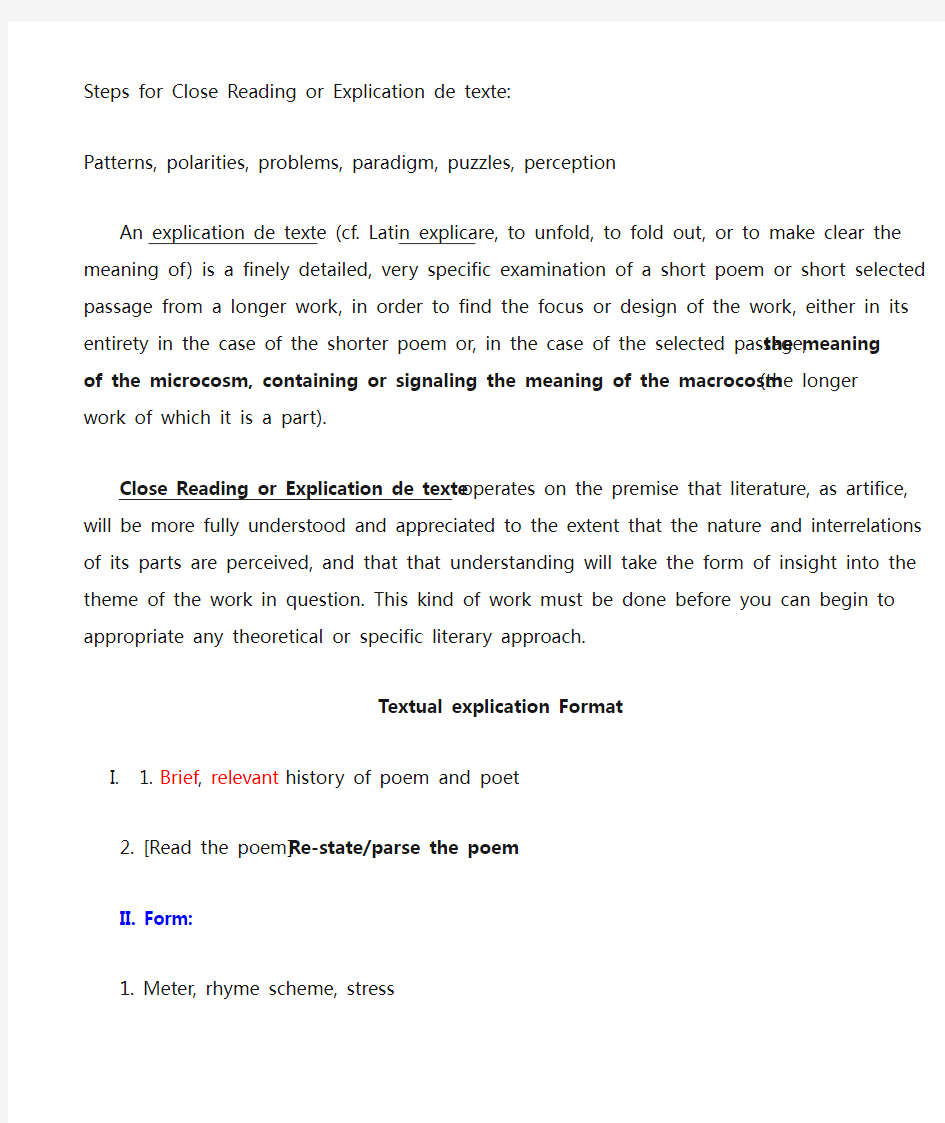
英国文学诗歌鉴赏作业Format
- 格式:doc
- 大小:33.00 KB
- 文档页数:2


Steps for Close Reading or Explication de texte:
Patterns, polarities, problems, paradigm, puzzles, perception
An explication de texte (cf. Latin explicare, to unfold, to fold out, or to make clear the meaning of) is a finely detailed, very specific examination of a short poem or short selected passage from a longer work, in order to find the focus or design of the work, either in its entirety in the case of the shorter poem or, in the case of the selected passage, the meaning of the microcosm, containing or signaling the meaning of the macrocosm (the longer work of which it is a part).
Close Reading or Explication de texte operates on the premise that literature, as artifice, will be more fully understood and appreciated to the extent that the nature and interrelations of its parts are perceived, and that that understanding will take the form of insight into the theme of the work in question. This kind of work must be done before you can begin to appropriate any theoretical or specific literary approach.
Textual explication Format
I. 1. Brief, relevant history of poem and poet
2. [Read the poem] Re-state/parse the poem
II. Form:
1. Meter, rhyme scheme, stress
2. Special characteristics if any [e.g. alliteration, personification, metaphor, etc.], and their importance to meaning.
III. Content:
1. theme
2. Your individual understanding of the poem
-------------------------------------------------------------------------------------------------------------------
Sample Textual explication
John Lyly (1554-1606), “Cupid and My Campaspes”
Cupid and my Campaspe played
At cards for kisses; Cupid paid.
He stakes his quiver, bows, and arrows.
His mother’s doves and team of sparrows,
Loses them too; then down he throws
The coral of his lips, the rose
Growing on’s cheek (but none knows how),
With these the crystal of his brow,
And then the dimple of his chin:
All these did my Campaspe win.
At last he set her both his eyes;
She won, and Cupid blind did rise.
Oh Love! Has she done this to thee?
What shall, alas, become of me?
I. John Lyly was an English writer, poet, dramatist, playwright, and politician, best known for his books Euphues, The Anatomy of Wit (1578) and Euphues and His England (1580). Lyly's literary style, originating in his first books, is known as euphuism. John Lyly produced his
comedy Campaspe in 1584. Campaspe was Alexander the Great's mistress. She was famously painted by a number of ancient painters. "Campaspe" eventually became a generic name for a man's mistress in poetry.
2. Parse
Cupid plays cards with my lover in order to win kisses, but he keeps losing. He risks his quiver, bows, arrows, his mother Venus’ doves and team of sparrows for the game, but loses all the stuff. Then, my lover wins all of his godlike good looks (his red lips, the red flush on his cheek, his fine brow, his dimple and his eyes). Finally, Cupid has to quit the game and flies away
without eyes (this explains why love is blind). Oh, the god of love, Cupid! Has my lover done this to you? Are you blind? Alas, if that is the case, what shall happen to me?
II. Form:
1.This poem contains fourteen lines of iambic tetrameter rimed aa bb cc dd ee ff gg, with
exceptions occur in line 1 ' U/ U' / U' / U' (Cupid and my Campaspe played), line 5 ' U/ U' / U' / U' (Loses them too; then down he throws) and line 7 ' U/ U' / U' / U' (Growing on’s cheek but none knows how).
2.There are three unusual features in this poem: the enjambment that occurs between line 5 and
line 6 (Loses them too; then down he throws/ The coral of his lips, the rose) as well as line 6 and line 7(The coral of his lips, the rose/ Growing on’s cheek (but none knows how)); the caesura occurs in line 2 and line 13; and the personification of love that occurs at the last couplet.
III. Content:
1. theme
The theme of the poem is ‘the blindness of love’. The poet stresses the power of love through an imagined game in which the lover of ‘I’ beats Cupid in a card game, and thus expresses his feeling of being overwhelmed by love and not able to escape from the charm of his lover. If this woman is able to so completely dominate a GOD, how can the poet resist her power and charms?
2. Evaluation
This poem applies excellent imagination and personification to achieve the purpose of influencing the reader. This is similar to Drayton’s‘since there’s no help, come let us kiss and part,’ in which personification and imagination are highly exposed. And this poem is that Lyly amusingly combines the classical (Campaspe, Cupid) with the contemporary (gambling).